Risk Management Report: NatureCare Products Business Expansion Project
VerifiedAdded on 2022/12/28
|17
|4297
|100
Report
AI Summary
This comprehensive risk management report analyzes the proposed business expansion of NatureCare Products, focusing on the establishment of three retail outlets. The report outlines the risk management process, including risk identification, stakeholder analysis (internal and external), and the legislative and regulatory context. It identifies potential risks related to market threats, changing consumer demands, competition, and internal financial risks. The report also presents a SWOT and PESTLE analysis to evaluate the company's strengths, weaknesses, opportunities, and threats within the business environment. Additionally, the report discusses critical success factors, goals, and objectives for the expansion project, providing valuable insights for effective risk mitigation and management.
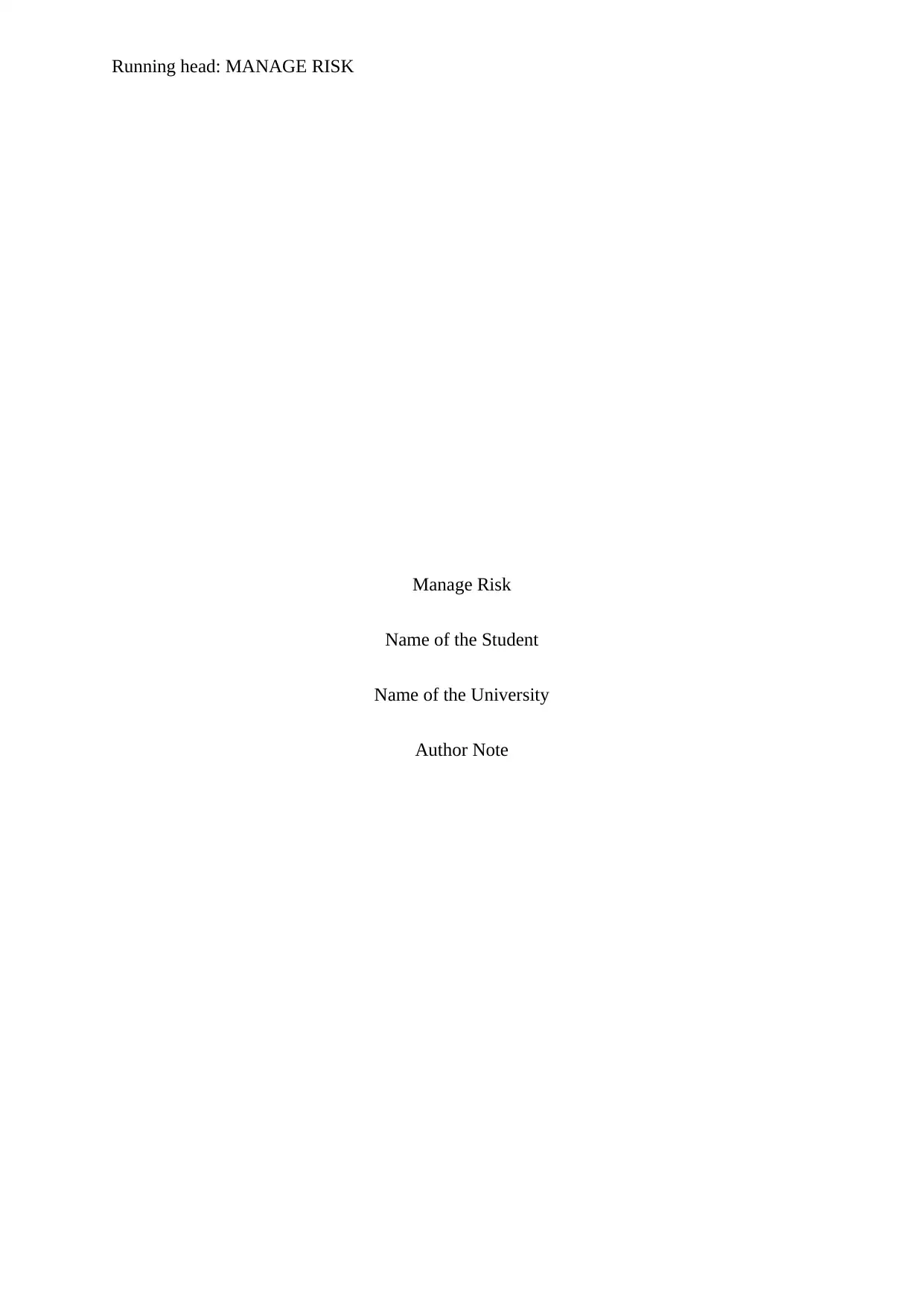
Running head: MANAGE RISK
Manage Risk
Name of the Student
Name of the University
Author Note
Manage Risk
Name of the Student
Name of the University
Author Note
Paraphrase This Document
Need a fresh take? Get an instant paraphrase of this document with our AI Paraphraser

1MANAGE RISK
Assessment Task 1:
To the CEO
NatureCare Products
Respected Sir,
Introduction
This research report is a risk management process analysis for the proposed business
expansion objectives of the organization NatureCare Products. NatureCare is supposed to
expand its business by establishing three retail outlets. The report discusses the risks that
organisation might observe when establishing retail outlets as the implantation of business
expansion objectives. Hence, the risks that are presented includes both external and internal
environment of the organization such as the risk related to market threats, changing
consumers’ needs and demands, entry of new parties, government regulations, internal
financial risk, etc. According to Pritchard and PMP (2014), business risk comes in different
tangible and intangible forms over the course of some business cycle and some could even
take place during ordinary course of corporate operations, but some occurs due to the
extraordinary circumstances that are not perfectly identified.
Outline of the risk management process
Risk management process is more of a framework particular for the actions that
requires to be implemented (Serpella et al. 2014). Theoretically, it is learnt that the first step
of risk management process is to identify the risk in business; thereby when it is considered
in an organizational context, it has been identified that NatureCare identifies the need for risk
management to treat as a consideration in strategic as well as operational planning, daily
operational management and in business decision-making. NatureCare’s risk management
Assessment Task 1:
To the CEO
NatureCare Products
Respected Sir,
Introduction
This research report is a risk management process analysis for the proposed business
expansion objectives of the organization NatureCare Products. NatureCare is supposed to
expand its business by establishing three retail outlets. The report discusses the risks that
organisation might observe when establishing retail outlets as the implantation of business
expansion objectives. Hence, the risks that are presented includes both external and internal
environment of the organization such as the risk related to market threats, changing
consumers’ needs and demands, entry of new parties, government regulations, internal
financial risk, etc. According to Pritchard and PMP (2014), business risk comes in different
tangible and intangible forms over the course of some business cycle and some could even
take place during ordinary course of corporate operations, but some occurs due to the
extraordinary circumstances that are not perfectly identified.
Outline of the risk management process
Risk management process is more of a framework particular for the actions that
requires to be implemented (Serpella et al. 2014). Theoretically, it is learnt that the first step
of risk management process is to identify the risk in business; thereby when it is considered
in an organizational context, it has been identified that NatureCare identifies the need for risk
management to treat as a consideration in strategic as well as operational planning, daily
operational management and in business decision-making. NatureCare’s risk management
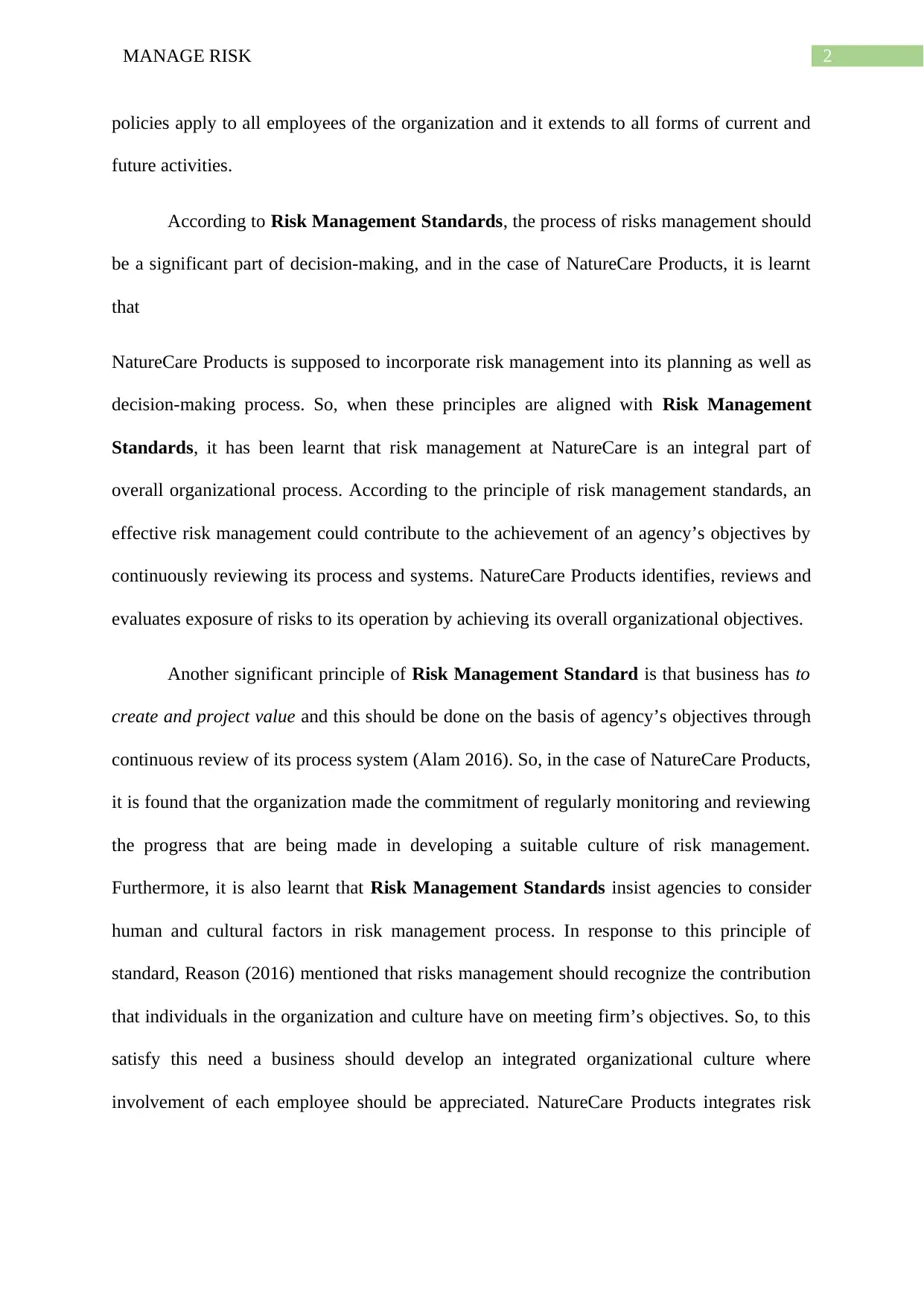
2MANAGE RISK
policies apply to all employees of the organization and it extends to all forms of current and
future activities.
According to Risk Management Standards, the process of risks management should
be a significant part of decision-making, and in the case of NatureCare Products, it is learnt
that
NatureCare Products is supposed to incorporate risk management into its planning as well as
decision-making process. So, when these principles are aligned with Risk Management
Standards, it has been learnt that risk management at NatureCare is an integral part of
overall organizational process. According to the principle of risk management standards, an
effective risk management could contribute to the achievement of an agency’s objectives by
continuously reviewing its process and systems. NatureCare Products identifies, reviews and
evaluates exposure of risks to its operation by achieving its overall organizational objectives.
Another significant principle of Risk Management Standard is that business has to
create and project value and this should be done on the basis of agency’s objectives through
continuous review of its process system (Alam 2016). So, in the case of NatureCare Products,
it is found that the organization made the commitment of regularly monitoring and reviewing
the progress that are being made in developing a suitable culture of risk management.
Furthermore, it is also learnt that Risk Management Standards insist agencies to consider
human and cultural factors in risk management process. In response to this principle of
standard, Reason (2016) mentioned that risks management should recognize the contribution
that individuals in the organization and culture have on meeting firm’s objectives. So, to this
satisfy this need a business should develop an integrated organizational culture where
involvement of each employee should be appreciated. NatureCare Products integrates risk
policies apply to all employees of the organization and it extends to all forms of current and
future activities.
According to Risk Management Standards, the process of risks management should
be a significant part of decision-making, and in the case of NatureCare Products, it is learnt
that
NatureCare Products is supposed to incorporate risk management into its planning as well as
decision-making process. So, when these principles are aligned with Risk Management
Standards, it has been learnt that risk management at NatureCare is an integral part of
overall organizational process. According to the principle of risk management standards, an
effective risk management could contribute to the achievement of an agency’s objectives by
continuously reviewing its process and systems. NatureCare Products identifies, reviews and
evaluates exposure of risks to its operation by achieving its overall organizational objectives.
Another significant principle of Risk Management Standard is that business has to
create and project value and this should be done on the basis of agency’s objectives through
continuous review of its process system (Alam 2016). So, in the case of NatureCare Products,
it is found that the organization made the commitment of regularly monitoring and reviewing
the progress that are being made in developing a suitable culture of risk management.
Furthermore, it is also learnt that Risk Management Standards insist agencies to consider
human and cultural factors in risk management process. In response to this principle of
standard, Reason (2016) mentioned that risks management should recognize the contribution
that individuals in the organization and culture have on meeting firm’s objectives. So, to this
satisfy this need a business should develop an integrated organizational culture where
involvement of each employee should be appreciated. NatureCare Products integrates risk
⊘ This is a preview!⊘
Do you want full access?
Subscribe today to unlock all pages.

Trusted by 1+ million students worldwide
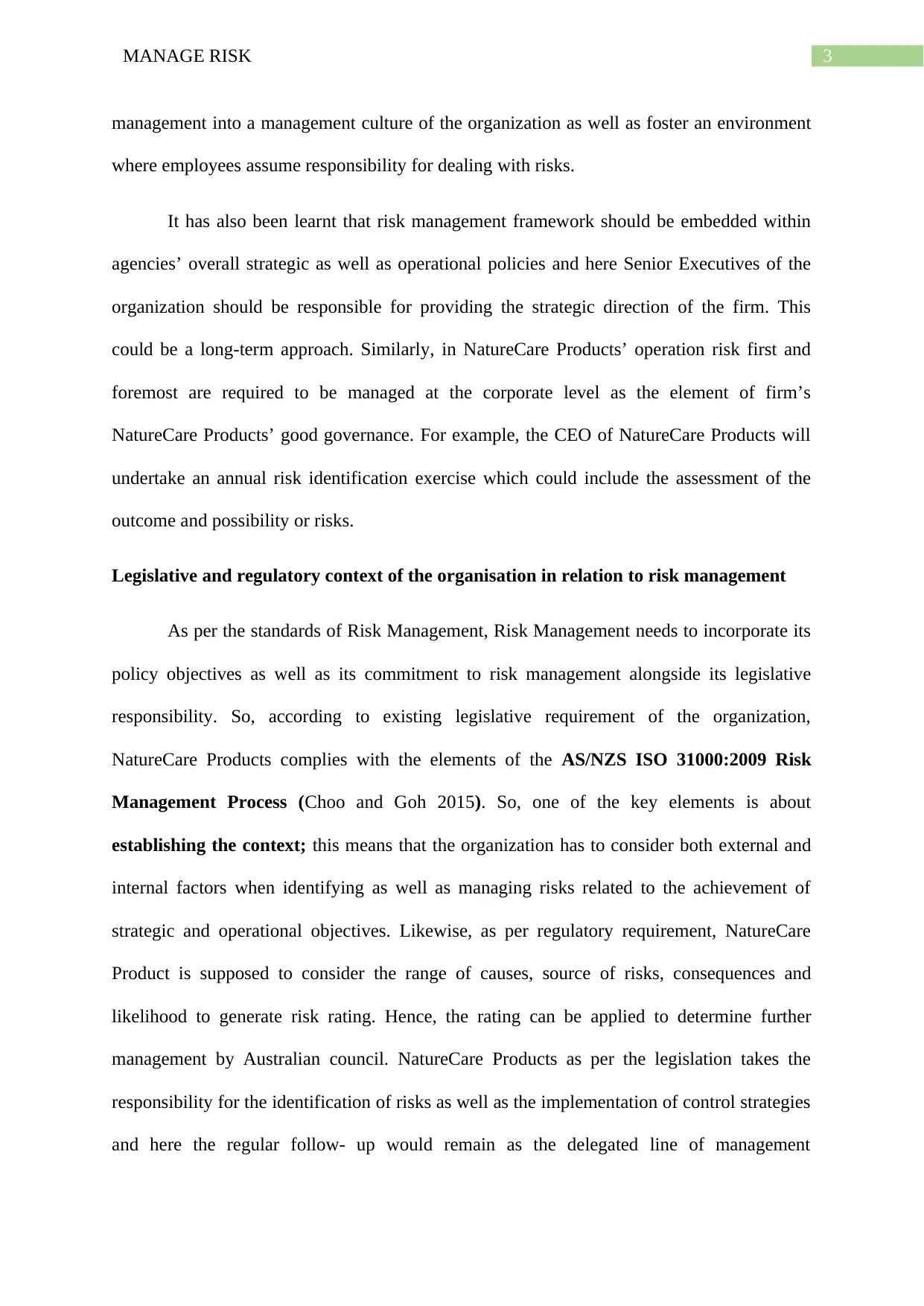
3MANAGE RISK
management into a management culture of the organization as well as foster an environment
where employees assume responsibility for dealing with risks.
It has also been learnt that risk management framework should be embedded within
agencies’ overall strategic as well as operational policies and here Senior Executives of the
organization should be responsible for providing the strategic direction of the firm. This
could be a long-term approach. Similarly, in NatureCare Products’ operation risk first and
foremost are required to be managed at the corporate level as the element of firm’s
NatureCare Products’ good governance. For example, the CEO of NatureCare Products will
undertake an annual risk identification exercise which could include the assessment of the
outcome and possibility or risks.
Legislative and regulatory context of the organisation in relation to risk management
As per the standards of Risk Management, Risk Management needs to incorporate its
policy objectives as well as its commitment to risk management alongside its legislative
responsibility. So, according to existing legislative requirement of the organization,
NatureCare Products complies with the elements of the AS/NZS ISO 31000:2009 Risk
Management Process (Choo and Goh 2015). So, one of the key elements is about
establishing the context; this means that the organization has to consider both external and
internal factors when identifying as well as managing risks related to the achievement of
strategic and operational objectives. Likewise, as per regulatory requirement, NatureCare
Product is supposed to consider the range of causes, source of risks, consequences and
likelihood to generate risk rating. Hence, the rating can be applied to determine further
management by Australian council. NatureCare Products as per the legislation takes the
responsibility for the identification of risks as well as the implementation of control strategies
and here the regular follow- up would remain as the delegated line of management
management into a management culture of the organization as well as foster an environment
where employees assume responsibility for dealing with risks.
It has also been learnt that risk management framework should be embedded within
agencies’ overall strategic as well as operational policies and here Senior Executives of the
organization should be responsible for providing the strategic direction of the firm. This
could be a long-term approach. Similarly, in NatureCare Products’ operation risk first and
foremost are required to be managed at the corporate level as the element of firm’s
NatureCare Products’ good governance. For example, the CEO of NatureCare Products will
undertake an annual risk identification exercise which could include the assessment of the
outcome and possibility or risks.
Legislative and regulatory context of the organisation in relation to risk management
As per the standards of Risk Management, Risk Management needs to incorporate its
policy objectives as well as its commitment to risk management alongside its legislative
responsibility. So, according to existing legislative requirement of the organization,
NatureCare Products complies with the elements of the AS/NZS ISO 31000:2009 Risk
Management Process (Choo and Goh 2015). So, one of the key elements is about
establishing the context; this means that the organization has to consider both external and
internal factors when identifying as well as managing risks related to the achievement of
strategic and operational objectives. Likewise, as per regulatory requirement, NatureCare
Product is supposed to consider the range of causes, source of risks, consequences and
likelihood to generate risk rating. Hence, the rating can be applied to determine further
management by Australian council. NatureCare Products as per the legislation takes the
responsibility for the identification of risks as well as the implementation of control strategies
and here the regular follow- up would remain as the delegated line of management
Paraphrase This Document
Need a fresh take? Get an instant paraphrase of this document with our AI Paraphraser
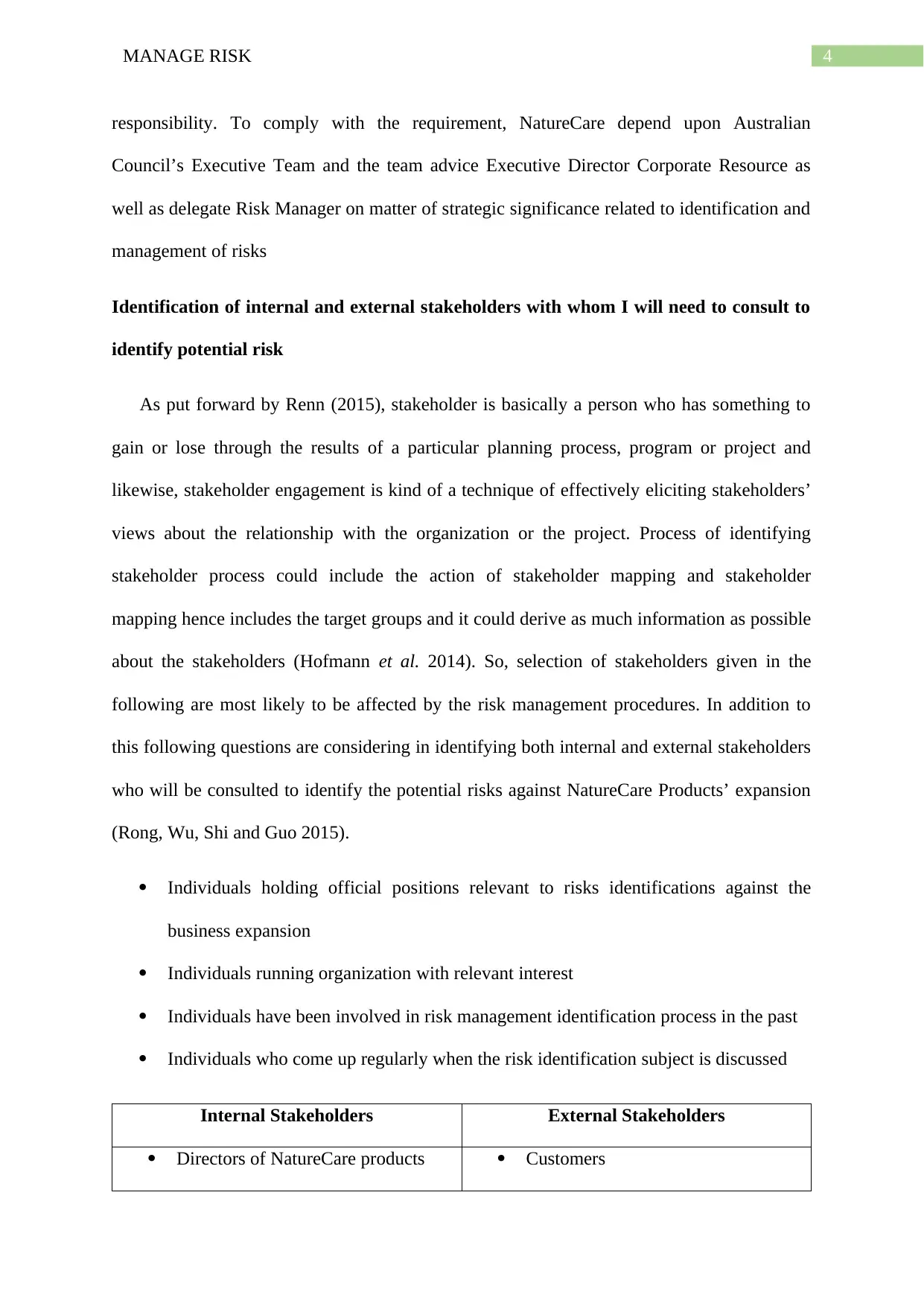
4MANAGE RISK
responsibility. To comply with the requirement, NatureCare depend upon Australian
Council’s Executive Team and the team advice Executive Director Corporate Resource as
well as delegate Risk Manager on matter of strategic significance related to identification and
management of risks
Identification of internal and external stakeholders with whom I will need to consult to
identify potential risk
As put forward by Renn (2015), stakeholder is basically a person who has something to
gain or lose through the results of a particular planning process, program or project and
likewise, stakeholder engagement is kind of a technique of effectively eliciting stakeholders’
views about the relationship with the organization or the project. Process of identifying
stakeholder process could include the action of stakeholder mapping and stakeholder
mapping hence includes the target groups and it could derive as much information as possible
about the stakeholders (Hofmann et al. 2014). So, selection of stakeholders given in the
following are most likely to be affected by the risk management procedures. In addition to
this following questions are considering in identifying both internal and external stakeholders
who will be consulted to identify the potential risks against NatureCare Products’ expansion
(Rong, Wu, Shi and Guo 2015).
Individuals holding official positions relevant to risks identifications against the
business expansion
Individuals running organization with relevant interest
Individuals have been involved in risk management identification process in the past
Individuals who come up regularly when the risk identification subject is discussed
Internal Stakeholders External Stakeholders
Directors of NatureCare products Customers
responsibility. To comply with the requirement, NatureCare depend upon Australian
Council’s Executive Team and the team advice Executive Director Corporate Resource as
well as delegate Risk Manager on matter of strategic significance related to identification and
management of risks
Identification of internal and external stakeholders with whom I will need to consult to
identify potential risk
As put forward by Renn (2015), stakeholder is basically a person who has something to
gain or lose through the results of a particular planning process, program or project and
likewise, stakeholder engagement is kind of a technique of effectively eliciting stakeholders’
views about the relationship with the organization or the project. Process of identifying
stakeholder process could include the action of stakeholder mapping and stakeholder
mapping hence includes the target groups and it could derive as much information as possible
about the stakeholders (Hofmann et al. 2014). So, selection of stakeholders given in the
following are most likely to be affected by the risk management procedures. In addition to
this following questions are considering in identifying both internal and external stakeholders
who will be consulted to identify the potential risks against NatureCare Products’ expansion
(Rong, Wu, Shi and Guo 2015).
Individuals holding official positions relevant to risks identifications against the
business expansion
Individuals running organization with relevant interest
Individuals have been involved in risk management identification process in the past
Individuals who come up regularly when the risk identification subject is discussed
Internal Stakeholders External Stakeholders
Directors of NatureCare products Customers

5MANAGE RISK
CEO of NatureCare Products
Other Board Committee Members
Employees
Government Authorities
Suppliers
Media Partners
Local market authority councils
Issues that stakeholders might raise in relation to risk identification process
Renn (2015) mentioned that the influence stakeholders might have on organizational policy,
strategy as well as the project is dependent particularly in the relationship to either
organization itself or the issue of concern. If the influence of risk management process is
considered on stakeholders, it can be mentioned that individuals who are funding the
expansion projects could be most likely to be affected (Hofmann et al. 2014).
The internal stakeholders such as the directors of NatureCare Products might raise
the concern against the cost of risk identification programs. For example, the expansion of
three different outlets in a dynamic markets where consumers’ taste and preferences are
rapidly changing is certainly risky. So, to cover up the needs of risk identification program in
each section of the business could require enormous cost. Conversely, the government
authorities might tighten the trade policies of three excessive outlets at a time. So, the risks
management policies and procedures of NatureCare would be scrutinized and reviewed by
Australian Council’s Executive teams on a frequent basis. (Noe et al. 2017)
This may take plenty of time and consequently the overall operation of the firm may
delay. Moreover, expansion of existing business is certainly a pressure on the suppliers if the
profits that suppliers gains are omitted in this context. The proposed risk management
policies and procedures of the organization could create significant impact on the suppliers
CEO of NatureCare Products
Other Board Committee Members
Employees
Government Authorities
Suppliers
Media Partners
Local market authority councils
Issues that stakeholders might raise in relation to risk identification process
Renn (2015) mentioned that the influence stakeholders might have on organizational policy,
strategy as well as the project is dependent particularly in the relationship to either
organization itself or the issue of concern. If the influence of risk management process is
considered on stakeholders, it can be mentioned that individuals who are funding the
expansion projects could be most likely to be affected (Hofmann et al. 2014).
The internal stakeholders such as the directors of NatureCare Products might raise
the concern against the cost of risk identification programs. For example, the expansion of
three different outlets in a dynamic markets where consumers’ taste and preferences are
rapidly changing is certainly risky. So, to cover up the needs of risk identification program in
each section of the business could require enormous cost. Conversely, the government
authorities might tighten the trade policies of three excessive outlets at a time. So, the risks
management policies and procedures of NatureCare would be scrutinized and reviewed by
Australian Council’s Executive teams on a frequent basis. (Noe et al. 2017)
This may take plenty of time and consequently the overall operation of the firm may
delay. Moreover, expansion of existing business is certainly a pressure on the suppliers if the
profits that suppliers gains are omitted in this context. The proposed risk management
policies and procedures of the organization could create significant impact on the suppliers
⊘ This is a preview!⊘
Do you want full access?
Subscribe today to unlock all pages.

Trusted by 1+ million students worldwide
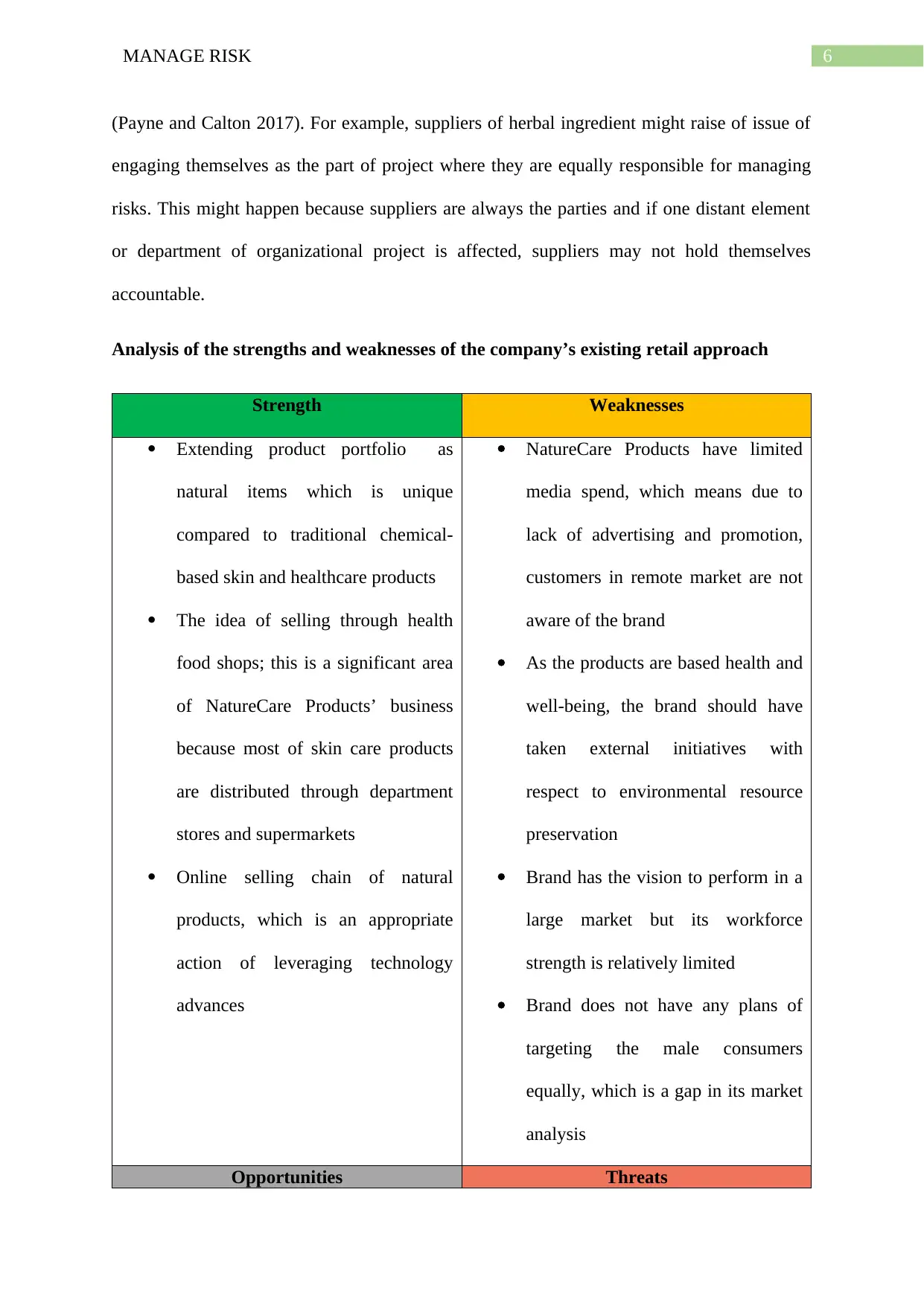
6MANAGE RISK
(Payne and Calton 2017). For example, suppliers of herbal ingredient might raise of issue of
engaging themselves as the part of project where they are equally responsible for managing
risks. This might happen because suppliers are always the parties and if one distant element
or department of organizational project is affected, suppliers may not hold themselves
accountable.
Analysis of the strengths and weaknesses of the company’s existing retail approach
Strength Weaknesses
Extending product portfolio as
natural items which is unique
compared to traditional chemical-
based skin and healthcare products
The idea of selling through health
food shops; this is a significant area
of NatureCare Products’ business
because most of skin care products
are distributed through department
stores and supermarkets
Online selling chain of natural
products, which is an appropriate
action of leveraging technology
advances
NatureCare Products have limited
media spend, which means due to
lack of advertising and promotion,
customers in remote market are not
aware of the brand
As the products are based health and
well-being, the brand should have
taken external initiatives with
respect to environmental resource
preservation
Brand has the vision to perform in a
large market but its workforce
strength is relatively limited
Brand does not have any plans of
targeting the male consumers
equally, which is a gap in its market
analysis
Opportunities Threats
(Payne and Calton 2017). For example, suppliers of herbal ingredient might raise of issue of
engaging themselves as the part of project where they are equally responsible for managing
risks. This might happen because suppliers are always the parties and if one distant element
or department of organizational project is affected, suppliers may not hold themselves
accountable.
Analysis of the strengths and weaknesses of the company’s existing retail approach
Strength Weaknesses
Extending product portfolio as
natural items which is unique
compared to traditional chemical-
based skin and healthcare products
The idea of selling through health
food shops; this is a significant area
of NatureCare Products’ business
because most of skin care products
are distributed through department
stores and supermarkets
Online selling chain of natural
products, which is an appropriate
action of leveraging technology
advances
NatureCare Products have limited
media spend, which means due to
lack of advertising and promotion,
customers in remote market are not
aware of the brand
As the products are based health and
well-being, the brand should have
taken external initiatives with
respect to environmental resource
preservation
Brand has the vision to perform in a
large market but its workforce
strength is relatively limited
Brand does not have any plans of
targeting the male consumers
equally, which is a gap in its market
analysis
Opportunities Threats
Paraphrase This Document
Need a fresh take? Get an instant paraphrase of this document with our AI Paraphraser
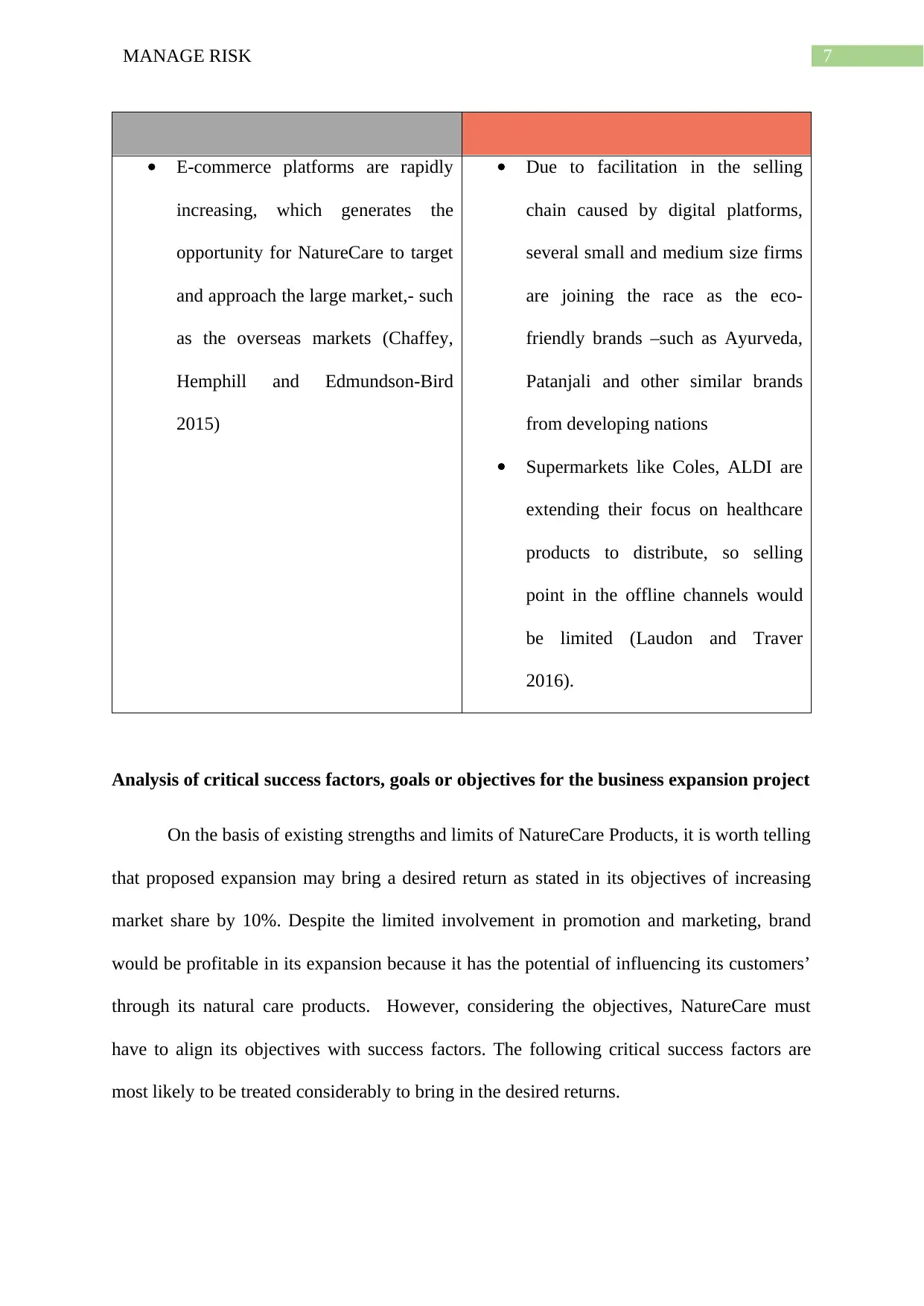
7MANAGE RISK
E-commerce platforms are rapidly
increasing, which generates the
opportunity for NatureCare to target
and approach the large market,- such
as the overseas markets (Chaffey,
Hemphill and Edmundson-Bird
2015)
Due to facilitation in the selling
chain caused by digital platforms,
several small and medium size firms
are joining the race as the eco-
friendly brands –such as Ayurveda,
Patanjali and other similar brands
from developing nations
Supermarkets like Coles, ALDI are
extending their focus on healthcare
products to distribute, so selling
point in the offline channels would
be limited (Laudon and Traver
2016).
Analysis of critical success factors, goals or objectives for the business expansion project
On the basis of existing strengths and limits of NatureCare Products, it is worth telling
that proposed expansion may bring a desired return as stated in its objectives of increasing
market share by 10%. Despite the limited involvement in promotion and marketing, brand
would be profitable in its expansion because it has the potential of influencing its customers’
through its natural care products. However, considering the objectives, NatureCare must
have to align its objectives with success factors. The following critical success factors are
most likely to be treated considerably to bring in the desired returns.
E-commerce platforms are rapidly
increasing, which generates the
opportunity for NatureCare to target
and approach the large market,- such
as the overseas markets (Chaffey,
Hemphill and Edmundson-Bird
2015)
Due to facilitation in the selling
chain caused by digital platforms,
several small and medium size firms
are joining the race as the eco-
friendly brands –such as Ayurveda,
Patanjali and other similar brands
from developing nations
Supermarkets like Coles, ALDI are
extending their focus on healthcare
products to distribute, so selling
point in the offline channels would
be limited (Laudon and Traver
2016).
Analysis of critical success factors, goals or objectives for the business expansion project
On the basis of existing strengths and limits of NatureCare Products, it is worth telling
that proposed expansion may bring a desired return as stated in its objectives of increasing
market share by 10%. Despite the limited involvement in promotion and marketing, brand
would be profitable in its expansion because it has the potential of influencing its customers’
through its natural care products. However, considering the objectives, NatureCare must
have to align its objectives with success factors. The following critical success factors are
most likely to be treated considerably to bring in the desired returns.
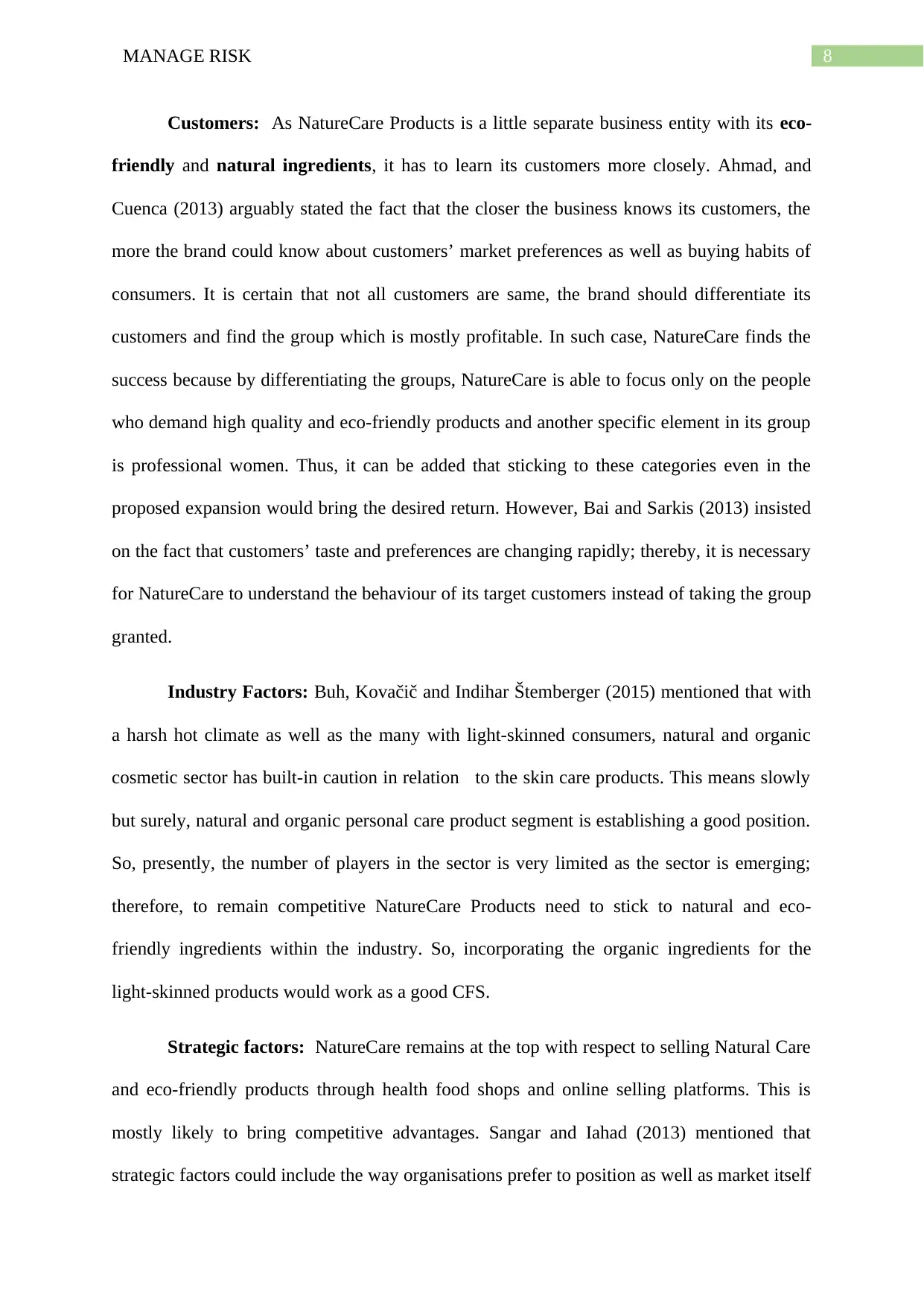
8MANAGE RISK
Customers: As NatureCare Products is a little separate business entity with its eco-
friendly and natural ingredients, it has to learn its customers more closely. Ahmad, and
Cuenca (2013) arguably stated the fact that the closer the business knows its customers, the
more the brand could know about customers’ market preferences as well as buying habits of
consumers. It is certain that not all customers are same, the brand should differentiate its
customers and find the group which is mostly profitable. In such case, NatureCare finds the
success because by differentiating the groups, NatureCare is able to focus only on the people
who demand high quality and eco-friendly products and another specific element in its group
is professional women. Thus, it can be added that sticking to these categories even in the
proposed expansion would bring the desired return. However, Bai and Sarkis (2013) insisted
on the fact that customers’ taste and preferences are changing rapidly; thereby, it is necessary
for NatureCare to understand the behaviour of its target customers instead of taking the group
granted.
Industry Factors: Buh, Kovačič and Indihar Štemberger (2015) mentioned that with
a harsh hot climate as well as the many with light-skinned consumers, natural and organic
cosmetic sector has built-in caution in relation to the skin care products. This means slowly
but surely, natural and organic personal care product segment is establishing a good position.
So, presently, the number of players in the sector is very limited as the sector is emerging;
therefore, to remain competitive NatureCare Products need to stick to natural and eco-
friendly ingredients within the industry. So, incorporating the organic ingredients for the
light-skinned products would work as a good CFS.
Strategic factors: NatureCare remains at the top with respect to selling Natural Care
and eco-friendly products through health food shops and online selling platforms. This is
mostly likely to bring competitive advantages. Sangar and Iahad (2013) mentioned that
strategic factors could include the way organisations prefer to position as well as market itself
Customers: As NatureCare Products is a little separate business entity with its eco-
friendly and natural ingredients, it has to learn its customers more closely. Ahmad, and
Cuenca (2013) arguably stated the fact that the closer the business knows its customers, the
more the brand could know about customers’ market preferences as well as buying habits of
consumers. It is certain that not all customers are same, the brand should differentiate its
customers and find the group which is mostly profitable. In such case, NatureCare finds the
success because by differentiating the groups, NatureCare is able to focus only on the people
who demand high quality and eco-friendly products and another specific element in its group
is professional women. Thus, it can be added that sticking to these categories even in the
proposed expansion would bring the desired return. However, Bai and Sarkis (2013) insisted
on the fact that customers’ taste and preferences are changing rapidly; thereby, it is necessary
for NatureCare to understand the behaviour of its target customers instead of taking the group
granted.
Industry Factors: Buh, Kovačič and Indihar Štemberger (2015) mentioned that with
a harsh hot climate as well as the many with light-skinned consumers, natural and organic
cosmetic sector has built-in caution in relation to the skin care products. This means slowly
but surely, natural and organic personal care product segment is establishing a good position.
So, presently, the number of players in the sector is very limited as the sector is emerging;
therefore, to remain competitive NatureCare Products need to stick to natural and eco-
friendly ingredients within the industry. So, incorporating the organic ingredients for the
light-skinned products would work as a good CFS.
Strategic factors: NatureCare remains at the top with respect to selling Natural Care
and eco-friendly products through health food shops and online selling platforms. This is
mostly likely to bring competitive advantages. Sangar and Iahad (2013) mentioned that
strategic factors could include the way organisations prefer to position as well as market itself
⊘ This is a preview!⊘
Do you want full access?
Subscribe today to unlock all pages.

Trusted by 1+ million students worldwide
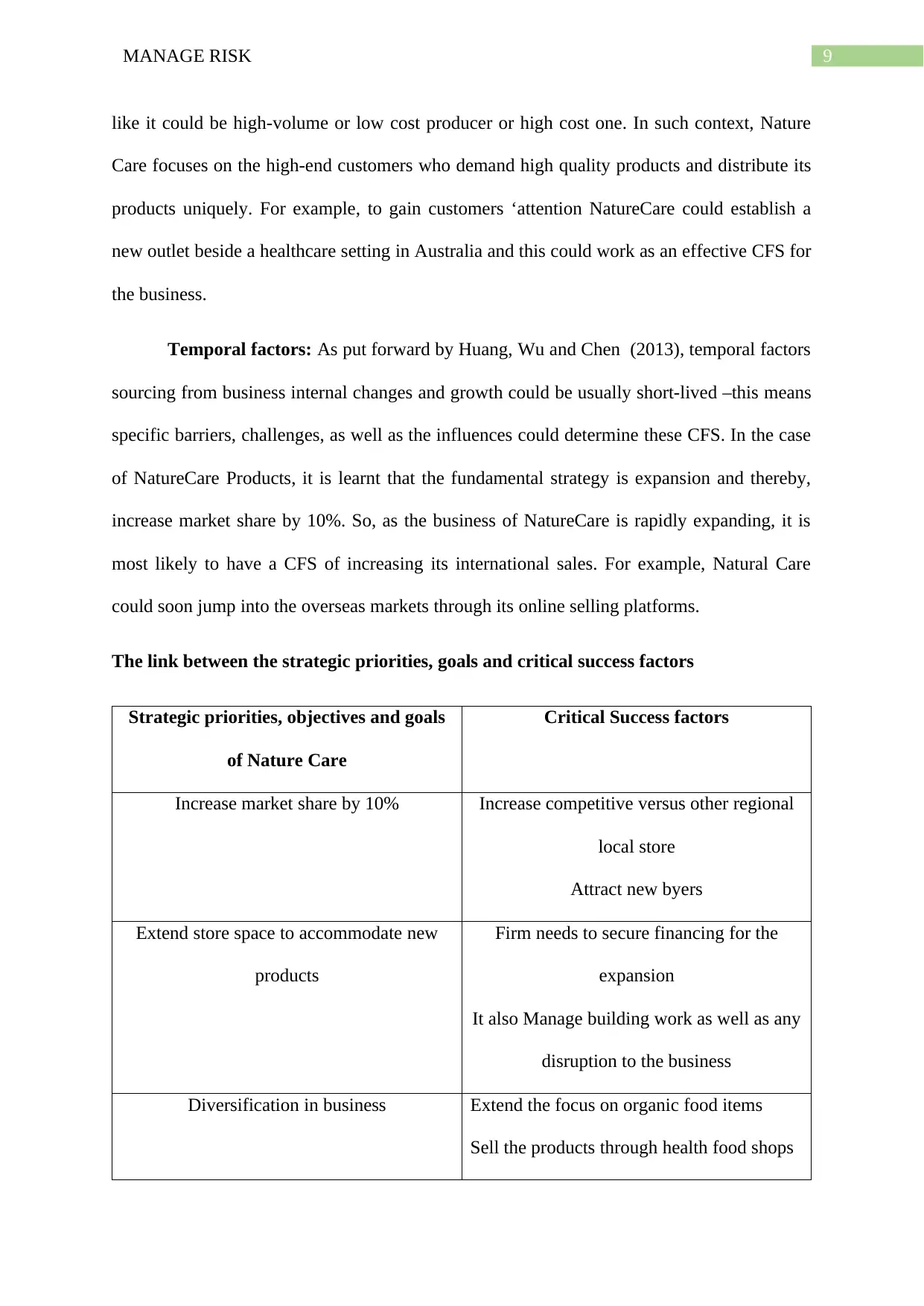
9MANAGE RISK
like it could be high-volume or low cost producer or high cost one. In such context, Nature
Care focuses on the high-end customers who demand high quality products and distribute its
products uniquely. For example, to gain customers ‘attention NatureCare could establish a
new outlet beside a healthcare setting in Australia and this could work as an effective CFS for
the business.
Temporal factors: As put forward by Huang, Wu and Chen (2013), temporal factors
sourcing from business internal changes and growth could be usually short-lived –this means
specific barriers, challenges, as well as the influences could determine these CFS. In the case
of NatureCare Products, it is learnt that the fundamental strategy is expansion and thereby,
increase market share by 10%. So, as the business of NatureCare is rapidly expanding, it is
most likely to have a CFS of increasing its international sales. For example, Natural Care
could soon jump into the overseas markets through its online selling platforms.
The link between the strategic priorities, goals and critical success factors
Strategic priorities, objectives and goals
of Nature Care
Critical Success factors
Increase market share by 10% Increase competitive versus other regional
local store
Attract new byers
Extend store space to accommodate new
products
Firm needs to secure financing for the
expansion
It also Manage building work as well as any
disruption to the business
Diversification in business Extend the focus on organic food items
Sell the products through health food shops
like it could be high-volume or low cost producer or high cost one. In such context, Nature
Care focuses on the high-end customers who demand high quality products and distribute its
products uniquely. For example, to gain customers ‘attention NatureCare could establish a
new outlet beside a healthcare setting in Australia and this could work as an effective CFS for
the business.
Temporal factors: As put forward by Huang, Wu and Chen (2013), temporal factors
sourcing from business internal changes and growth could be usually short-lived –this means
specific barriers, challenges, as well as the influences could determine these CFS. In the case
of NatureCare Products, it is learnt that the fundamental strategy is expansion and thereby,
increase market share by 10%. So, as the business of NatureCare is rapidly expanding, it is
most likely to have a CFS of increasing its international sales. For example, Natural Care
could soon jump into the overseas markets through its online selling platforms.
The link between the strategic priorities, goals and critical success factors
Strategic priorities, objectives and goals
of Nature Care
Critical Success factors
Increase market share by 10% Increase competitive versus other regional
local store
Attract new byers
Extend store space to accommodate new
products
Firm needs to secure financing for the
expansion
It also Manage building work as well as any
disruption to the business
Diversification in business Extend the focus on organic food items
Sell the products through health food shops
Paraphrase This Document
Need a fresh take? Get an instant paraphrase of this document with our AI Paraphraser
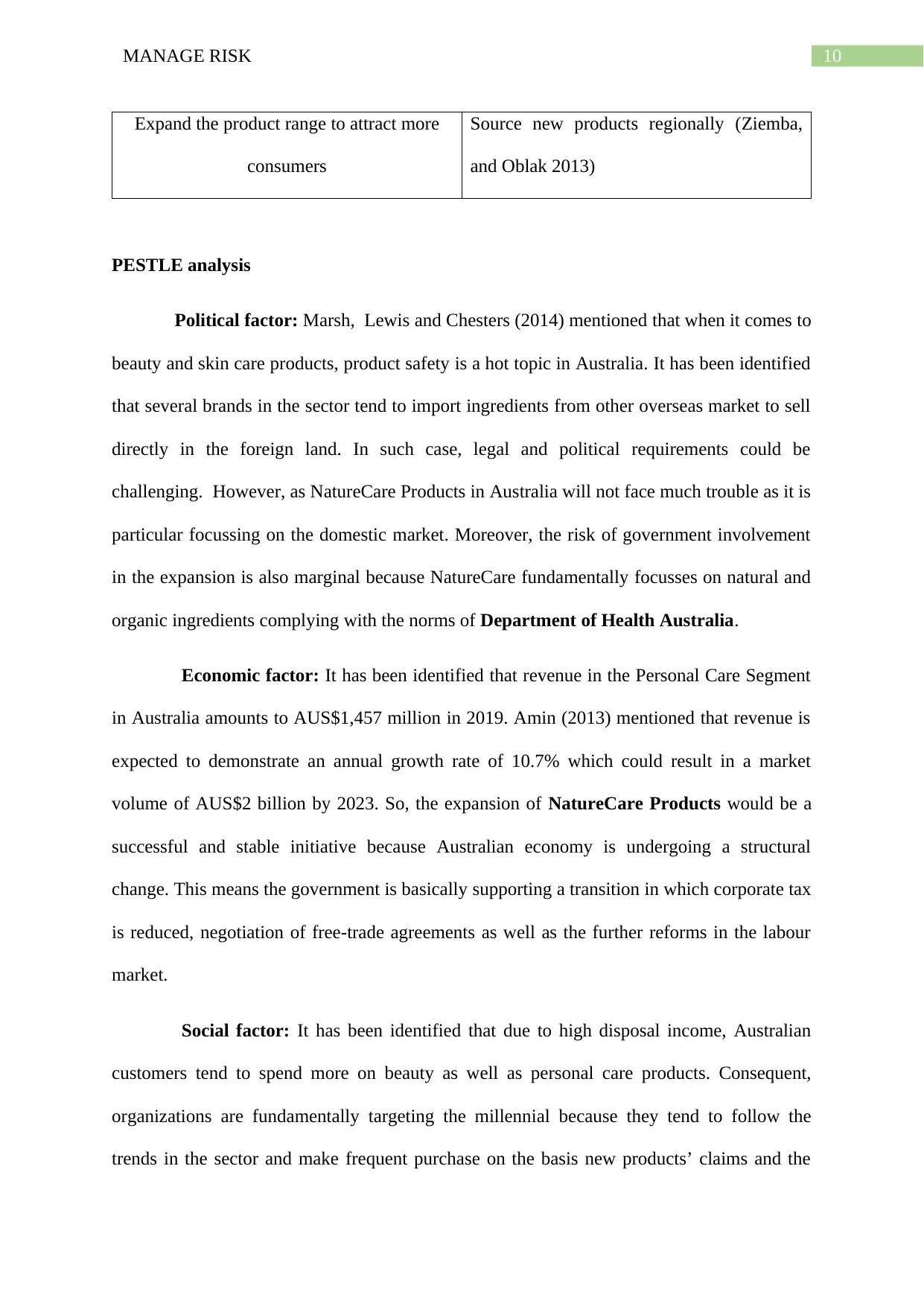
10MANAGE RISK
Expand the product range to attract more
consumers
Source new products regionally (Ziemba,
and Oblak 2013)
PESTLE analysis
Political factor: Marsh, Lewis and Chesters (2014) mentioned that when it comes to
beauty and skin care products, product safety is a hot topic in Australia. It has been identified
that several brands in the sector tend to import ingredients from other overseas market to sell
directly in the foreign land. In such case, legal and political requirements could be
challenging. However, as NatureCare Products in Australia will not face much trouble as it is
particular focussing on the domestic market. Moreover, the risk of government involvement
in the expansion is also marginal because NatureCare fundamentally focusses on natural and
organic ingredients complying with the norms of Department of Health Australia.
Economic factor: It has been identified that revenue in the Personal Care Segment
in Australia amounts to AUS$1,457 million in 2019. Amin (2013) mentioned that revenue is
expected to demonstrate an annual growth rate of 10.7% which could result in a market
volume of AUS$2 billion by 2023. So, the expansion of NatureCare Products would be a
successful and stable initiative because Australian economy is undergoing a structural
change. This means the government is basically supporting a transition in which corporate tax
is reduced, negotiation of free-trade agreements as well as the further reforms in the labour
market.
Social factor: It has been identified that due to high disposal income, Australian
customers tend to spend more on beauty as well as personal care products. Consequent,
organizations are fundamentally targeting the millennial because they tend to follow the
trends in the sector and make frequent purchase on the basis new products’ claims and the
Expand the product range to attract more
consumers
Source new products regionally (Ziemba,
and Oblak 2013)
PESTLE analysis
Political factor: Marsh, Lewis and Chesters (2014) mentioned that when it comes to
beauty and skin care products, product safety is a hot topic in Australia. It has been identified
that several brands in the sector tend to import ingredients from other overseas market to sell
directly in the foreign land. In such case, legal and political requirements could be
challenging. However, as NatureCare Products in Australia will not face much trouble as it is
particular focussing on the domestic market. Moreover, the risk of government involvement
in the expansion is also marginal because NatureCare fundamentally focusses on natural and
organic ingredients complying with the norms of Department of Health Australia.
Economic factor: It has been identified that revenue in the Personal Care Segment
in Australia amounts to AUS$1,457 million in 2019. Amin (2013) mentioned that revenue is
expected to demonstrate an annual growth rate of 10.7% which could result in a market
volume of AUS$2 billion by 2023. So, the expansion of NatureCare Products would be a
successful and stable initiative because Australian economy is undergoing a structural
change. This means the government is basically supporting a transition in which corporate tax
is reduced, negotiation of free-trade agreements as well as the further reforms in the labour
market.
Social factor: It has been identified that due to high disposal income, Australian
customers tend to spend more on beauty as well as personal care products. Consequent,
organizations are fundamentally targeting the millennial because they tend to follow the
trends in the sector and make frequent purchase on the basis new products’ claims and the
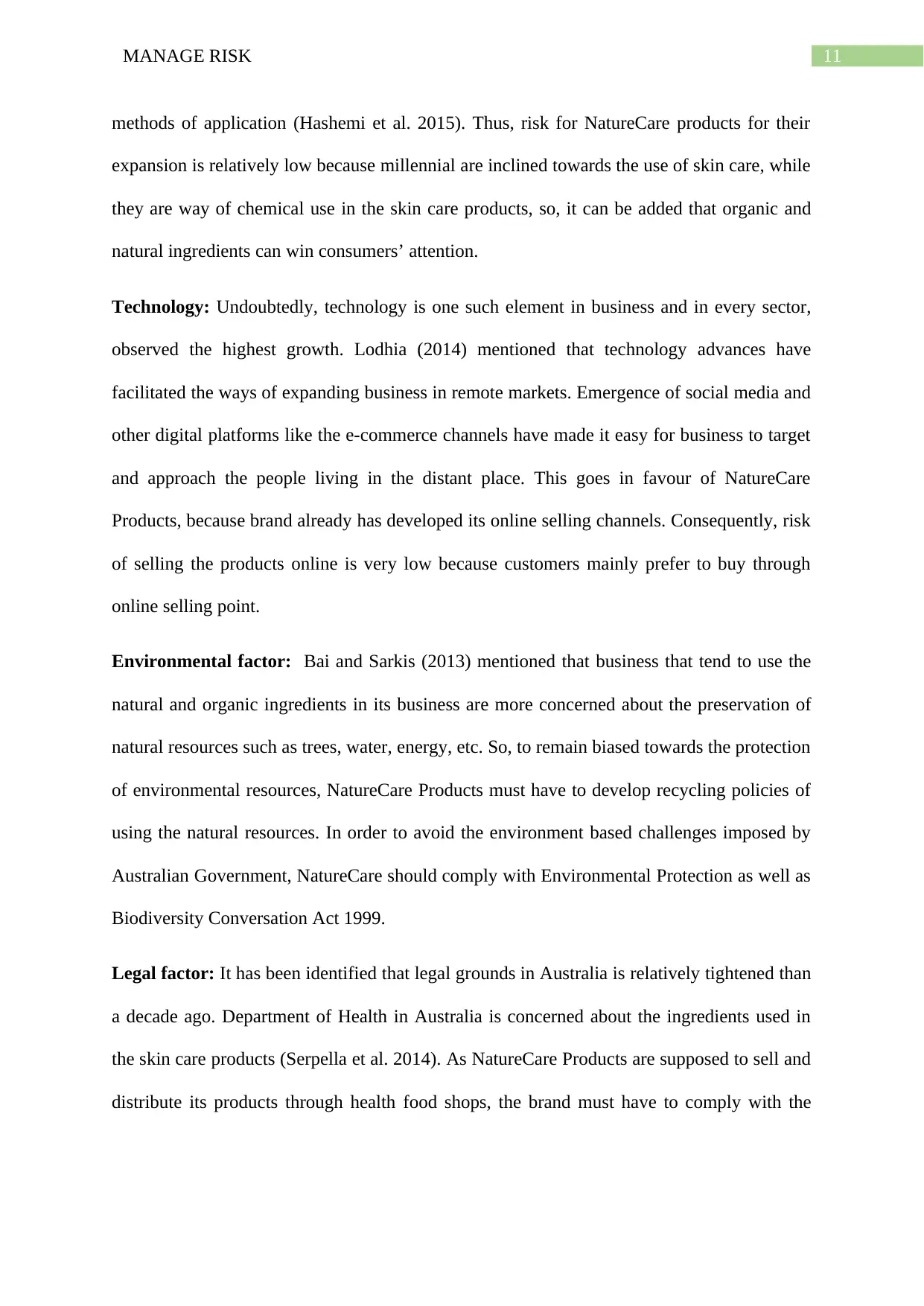
11MANAGE RISK
methods of application (Hashemi et al. 2015). Thus, risk for NatureCare products for their
expansion is relatively low because millennial are inclined towards the use of skin care, while
they are way of chemical use in the skin care products, so, it can be added that organic and
natural ingredients can win consumers’ attention.
Technology: Undoubtedly, technology is one such element in business and in every sector,
observed the highest growth. Lodhia (2014) mentioned that technology advances have
facilitated the ways of expanding business in remote markets. Emergence of social media and
other digital platforms like the e-commerce channels have made it easy for business to target
and approach the people living in the distant place. This goes in favour of NatureCare
Products, because brand already has developed its online selling channels. Consequently, risk
of selling the products online is very low because customers mainly prefer to buy through
online selling point.
Environmental factor: Bai and Sarkis (2013) mentioned that business that tend to use the
natural and organic ingredients in its business are more concerned about the preservation of
natural resources such as trees, water, energy, etc. So, to remain biased towards the protection
of environmental resources, NatureCare Products must have to develop recycling policies of
using the natural resources. In order to avoid the environment based challenges imposed by
Australian Government, NatureCare should comply with Environmental Protection as well as
Biodiversity Conversation Act 1999.
Legal factor: It has been identified that legal grounds in Australia is relatively tightened than
a decade ago. Department of Health in Australia is concerned about the ingredients used in
the skin care products (Serpella et al. 2014). As NatureCare Products are supposed to sell and
distribute its products through health food shops, the brand must have to comply with the
methods of application (Hashemi et al. 2015). Thus, risk for NatureCare products for their
expansion is relatively low because millennial are inclined towards the use of skin care, while
they are way of chemical use in the skin care products, so, it can be added that organic and
natural ingredients can win consumers’ attention.
Technology: Undoubtedly, technology is one such element in business and in every sector,
observed the highest growth. Lodhia (2014) mentioned that technology advances have
facilitated the ways of expanding business in remote markets. Emergence of social media and
other digital platforms like the e-commerce channels have made it easy for business to target
and approach the people living in the distant place. This goes in favour of NatureCare
Products, because brand already has developed its online selling channels. Consequently, risk
of selling the products online is very low because customers mainly prefer to buy through
online selling point.
Environmental factor: Bai and Sarkis (2013) mentioned that business that tend to use the
natural and organic ingredients in its business are more concerned about the preservation of
natural resources such as trees, water, energy, etc. So, to remain biased towards the protection
of environmental resources, NatureCare Products must have to develop recycling policies of
using the natural resources. In order to avoid the environment based challenges imposed by
Australian Government, NatureCare should comply with Environmental Protection as well as
Biodiversity Conversation Act 1999.
Legal factor: It has been identified that legal grounds in Australia is relatively tightened than
a decade ago. Department of Health in Australia is concerned about the ingredients used in
the skin care products (Serpella et al. 2014). As NatureCare Products are supposed to sell and
distribute its products through health food shops, the brand must have to comply with the
⊘ This is a preview!⊘
Do you want full access?
Subscribe today to unlock all pages.

Trusted by 1+ million students worldwide
1 out of 17
Related Documents
Your All-in-One AI-Powered Toolkit for Academic Success.
+13062052269
info@desklib.com
Available 24*7 on WhatsApp / Email
![[object Object]](/_next/static/media/star-bottom.7253800d.svg)
Unlock your academic potential
Copyright © 2020–2025 A2Z Services. All Rights Reserved. Developed and managed by ZUCOL.





